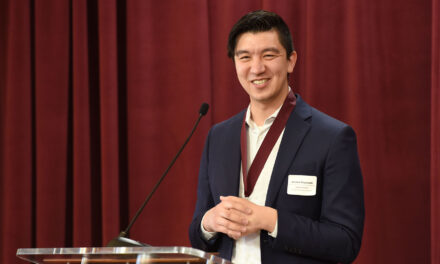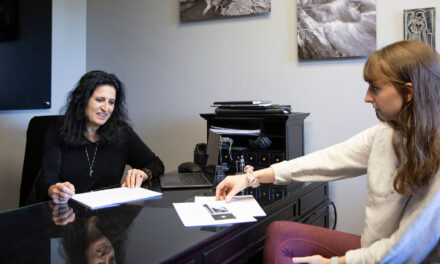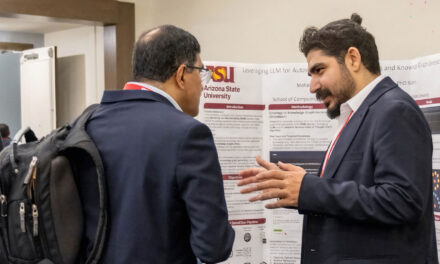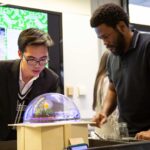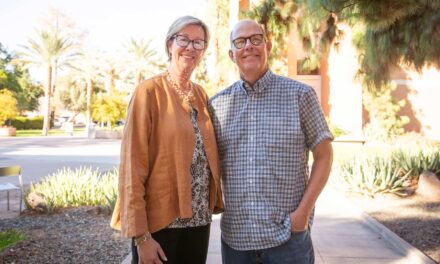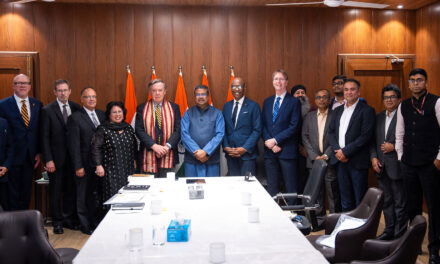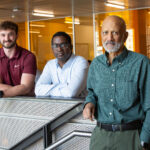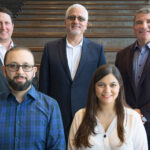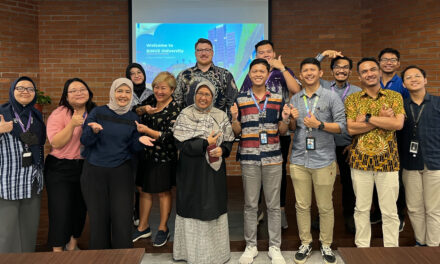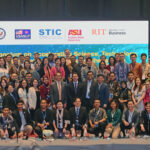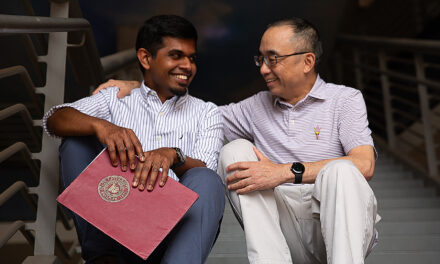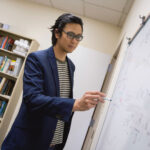
Rice, ASU, Yale, UTEP win coveted engineering research center
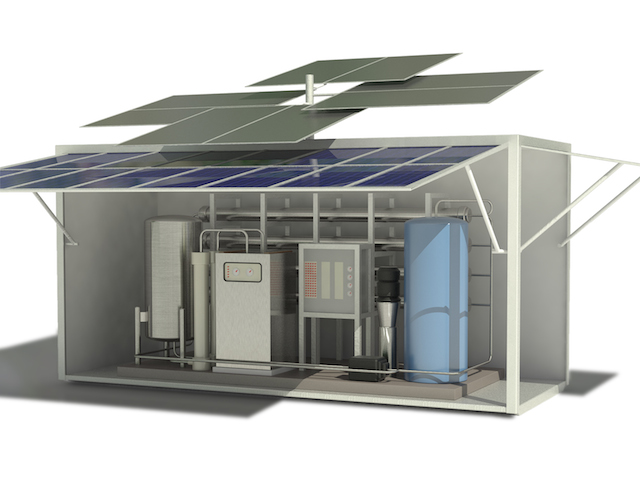
NEWT will develop modular, off-grid water-treatment technology. Credit: NEWT/Rice University
Nanotechnology Enabled Water Treatment (NEWT) Systems center will transform economics of water treatment
No other resource is as necessary for life as is water, and providing it safely and universally is a grand challenge inextricably linked to public health, energy production and sustainable development.
Arizona State University and a consortium of industry, university and government partners have been awarded $18.5 million to establish one of the National Science Foundation’s (NSF) prestigious Engineering Research Centers to develop compact, mobile, off-grid water-treatment systems that can provide clean water to millions of people who lack it and make U.S. energy production more sustainable and cost effective. ASU researchers have been allocated $3.2 million for their role in the center.
The Nanotechnology Enabled Water Treatment Systems center, or NEWT, will be led by and based at Rice University in Houston, Texas. It is funded by a five-year renewable NSF grant. NEWT brings together experts from ASU, Rice, the University of Texas at El Paso and Yale University to work with more than 30 partners, including Shell, Baker Hughes, UNESCO, the U.S. Army Corps of Engineers and the National Aeronautics and Space Administration (NASA).

NEWT deputy director is Paul Westerhoff, ASU vice provost for academic research and professor in the School of Sustainable Engineering and the Built Environment.
ERCs are interdisciplinary, multi-institutional entities that join academia, industry and government in partnership to produce both transformational technology and innovation-minded engineering graduates who are primed to lead the global economy. ERCs often become self-sustaining and typically leverage more than $50 million in federal and industry research funding during their first decade.
NEWT Director Pedro Alvarez, Rice’s George R. Brown Professor of Civil and Environmental Engineering and professor of chemistry, materials science and nanoengineering, said treated water is often unavailable in rural areas and low-resource communities that cannot afford large treatment plants or the miles of underground pipes needed to deliver water. Forty-three million Americans lack access to municipal water; 800 million worldwide lack access to safe water.
“The importance of clean water to global health and economic development simply cannot be overstated,” said Alvarez, the grant’s principal investigator. “We envision using technology and advanced materials to provide clean water to millions of people who lack it and to enable energy production in the United States to be more cost-effective and more sustainable in regard to its water footprint.”
NEWT deputy director is Paul Westerhoff, ASU vice provost for academic research and professor in the School of Sustainable Engineering and the Built Environment, one of the Ira A. Fulton Schools of Engineering.
“ASU is uniquely positioned to play a key role in this innovative center. Our school’s civil engineering curriculum focuses on sustainable engineering as a revolutionary approach to solve key human needs,” said G. Edward Gibson, director of the School for Sustainable Engineering and the Built Environment. Paul Westerhoff has garnered wide recognition for his work related to the treatment and occurrence of contaminants in water and for his multidisciplinary research. NEWT has the potential to create disruptive technology to improve the quality of life for millions of people and fits squarely into our vision for the School.”
According to Westerhoff the new modular water-treatment systems, which will be small enough to fit in the back of a tractor-trailer, will use nanoengineered catalysts, membranes and light-activated materials to change the economics of water treatment.

NEWT’s water-treatment systems will be compact enough to fit on the back of a tractor-trailer. Credit: NEWT/Rice University
“NEWT’s vision goes well beyond today’s technology,” said Westerhoff, who is also a senior scientist in ASU’s Julie Ann Wrigley Global Institute of Sustainability and co-principal investigator on the NSF grant. “We’ve set a path for transformative new technology that will move water treatment from a predominantly chemical treatment process to more efficient catalytic and physical processes that exploit solar energy and generate less waste.”
The research will include three focus areas: the development of multifunctional engineered nanomaterials to purify water, solar desalination of groundwater, and development of new methods for scaling and fouling control.
Some of the applications for the technologies will include novel under-sink water treatment systems to purify water. The market for this type of point-of-entry water treatment is between $2 billion and $5 billion.
NEWT’s water-treatment systems will be able to convert water from any source — including pond water, seawater and floodwater, into drinking water using solar energy — even under cloudy conditions, or other renewable energy sources.
The system’s modular units also will be easy to reconfigure to meet desired water-quality levels for virtually any situation. The system will include components that target suspended solids, microbes, dissolved contaminants and salts, and it will have the ability to treat a variety of industrial wastewater according to industry’s need for discharge or reuse.
NEWT will focus on applications for humanitarian emergency response, rural water systems and wastewater treatment and reuse at remote sites, including both onshore and offshore drilling platforms for oil and gas exploration.
“NEWT will provide affordable and efficient water treatment systems that remove current trade-offs between cost and performance and between energy consumption and treatment rate,” Westerhoff said. “These advantages will give NEWT products a competitive edge in emerging markets surrounding global health and decentralized water management.”
NEWT’s goal is to attract industry funding and become self-sufficient within 10 years. Toward that end, NEWT will carefully select industrial partners from every part of the water market, including equipment makers and vendors, system operators, industrial service firms and others.
Other ASU researchers working with NEWT include:
- Albert Brown, lecturer in environmental and resource management in the Polytechnic School.
- Adam Carberry, assistant professor in engineering and manufacturing engineering in the Polytechnic School.
- Candace Chan, assistant professor in the School for Engineering of Matter, Transport and Energy.
- Peter Fox, professor in the School of Sustainable Engineering and the Built Environment and senior scientist in the Julie Ann Wrigley Global Institute of Sustainability.
- Christiana Honsberg, professor in the School of Electrical, Computer and Energy Engineering.
- Kiril Hristovski, assistant professor in the Polytechnic School and senior sustainability scientist in the Julie Ann Wrigley Global Institute of Sustainability.
- Mary Laura Lind, assistant professor in the School for Engineering of Matter, Transport and Energy and senior sustainability scientist in the Julie Ann Wrigley Global Institute of Sustainability.
- Jekan Thanga, assistant professor in the School of Earth and Space Exploration.
NEWT is one of three new ERCs announced by the NSF today in Washington. These join 16 existing centers that are still receiving federal support.
High-resolution IMAGES are available for download at:
http://news.rice.edu/wp-content/uploads/2015/06/0629_NEWT-log-lg.jpg
CAPTION: NEWT will develop mobile, off-grid water-treatment systems that can provide clean water to millions of people who lack it. CREDIT: Rice University
http://news.rice.edu/wp-content/uploads/2015/06/0629_NEWT-mod-lg.jpg
CAPTION: NEWT will develop modular, off-grid water-treatment technology. CREDIT: NEWT/Rice University
http://news.rice.edu/wp-content/uploads/2015/06/0629_NEWT-truck-lg.jpg
CAPTION: NEWT’s water-treatment systems will be compact enough to fit on the back of a tractor-trailer. CREDIT: NEWT/Rice University
Video is available at: http://youtu.be/WvIiXqukFuA
By Sharon Keeler


